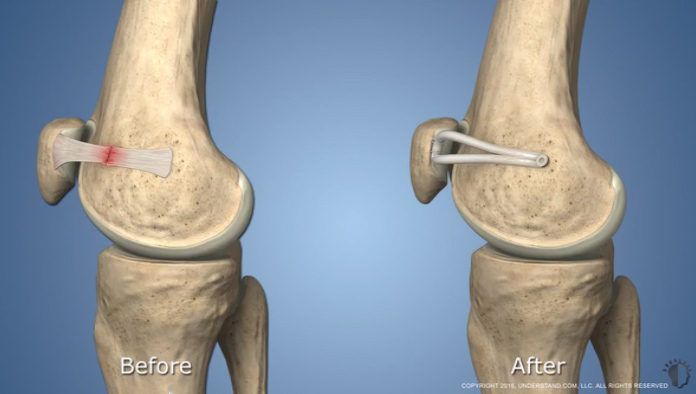Medial Patellofemoral Ligament (MPFL) Tear Reconstruction
MPFL reconstruction is a surgery in which a new medial patellofemoral ligament is created to stabilize the knee and help protect the joint from additional damage.
What is the medial patellofemoral ligament (MPFL)?
The medial patellofemoral ligament is a part of the complex network of soft tissues that stabilize the knee. The MPFL attaches the inside part of the patella (kneecap) to the long bone of the thigh, also called the femur.
Together, the patella and femur compose the patellofemoral joint.
Injury to the MPFL can occur when the patella dislocates or becomes subluxated (partially dislocated) due to a trauma experienced during athletics or an accident, as a result of naturally loose ligaments – most frequently seen in girls and women – or due to individual variations in bony anatomy. People with these injuries are described as having patellar instability.
What is MPFL reconstruction?
MPFL reconstruction is a surgery in which a new medial patellofemoral ligament is created to stabilize the knee and help protect the joint from additional damage.
It offers an excellent treatment option for people who have experienced more than one dislocation. The procedure is relatively new. Historically, although some patients benefitted from surgery to tighten the damaged ligament, as recently as around 2006, many individuals with damage to the MPFL had few treatment options beyond immobilization and rehabilitation.

Injury to the MPFL
In the healthy knee, the bones that make up the patellofemoral joint move smoothly against one another as the joint is flexed or extended. The patella glides in a trochlea (groove) of the femur. The MPFL plays a particularly important role in keeping the patella on track (that is, in this groove) by acting like a leash that restrains the patella’s movement.
When patellar dislocation occurs, soft tissues are damaged as the patella “jumps” the track and then comes forcibly back into place. Because the kneecap dislocates toward the outside of the leg, the ligament on the inside of the knee (the MPFL) gets torn.
Left untreated, an injured MPFL can heal on its own. However, when left alone, the ligament heals in a loosened, lengthened position. This causes instability that makes it easier for the patella to become dislocated again in the future. This, in turn can cause damage to the cartilage in the knee. While the pain, swelling and disability associated with a dislocated kneecap are problems in themselves, the greater concern is subsequent injury to the cartilage that covers the ends of the bones where they meet in the knee joint. Once this cartilage is damaged, you are put at a high risk of developing patellofemoral arthritis, a significantly more difficult condition to treat. For this reason, it always advisable to get treatment that will help prevent further dislocations of the kneecap.
What to expect after MPFL reconstruction
Immediately following MPFL reconstruction, patients can bear weight on the affected leg, which is placed in a brace that is worn for six weeks. The brace keeps the leg straight during walking. During recovery, a continuous passive motion machine (CPM) is used at home to avoid scar tissue and stiffness from developing in the joint as the ligament heals. The CPM machine moves the patellofemoral joint without the use of a patient’s muscles.
Once the quadriceps (the major muscle in the thigh) is strong enough to support the joint, the patient can begin physical therapy. This is usually about six weeks after surgery. Other measures that can speed up recovery include devices that provide electric stimulation to the muscles around the knee and Game Ready, a machine that compresses and cools the leg, thereby reducing swelling and pain. (Insurance may not cover the cost of these devices.)
Most people can generally return to sport or play sometime between 4 to 7 months after MPFL reconstruction. If you are considering the surgery, be aware than recovery times may vary and can be dependent on your individual anatomy, capacity to heal and general health prior to surgery.

